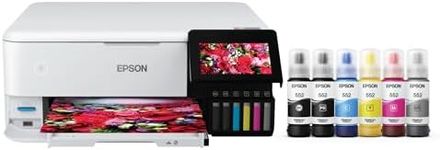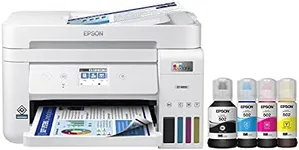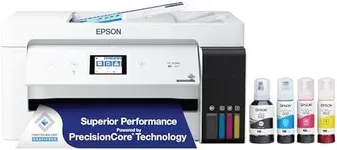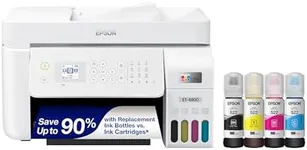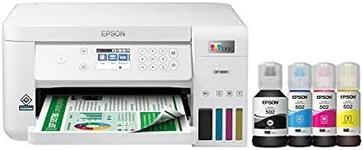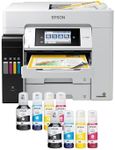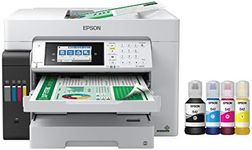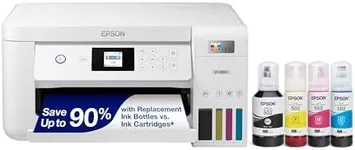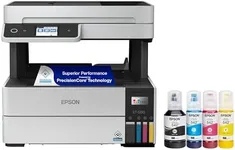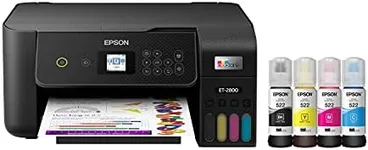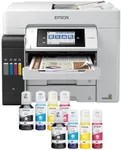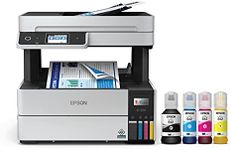Buying Guide for the Best Epson Printers
Choosing the right Epson printer can make a big difference in your daily tasks, whether you need it for home, school, or office use. The best approach is to think about what you’ll be printing most often—like documents, photos, or both—and how much you’ll print. Understanding the key features will help you match a printer to your needs, so you get the best performance and value for your situation.Print TechnologyPrint technology refers to the method the printer uses to put ink on paper. Epson mainly offers inkjet printers, which are great for both text and photo printing. Inkjet printers use liquid ink and are versatile, making them suitable for a wide range of tasks. If you print a lot of photos or need vibrant colors, inkjet is a good choice. For mostly text documents, inkjet still works well, but you might want to look for models optimized for sharp text.
Print SpeedPrint speed tells you how many pages per minute (ppm) the printer can produce. This is important if you often print large documents or need things done quickly. Lower speeds (up to 10 ppm) are fine for occasional home use, while higher speeds (15-30 ppm or more) are better for busy offices or frequent printing. Think about how often you print and how patient you are—if you print a lot at once, a faster printer will save you time.
Print ResolutionPrint resolution, measured in dots per inch (dpi), affects how sharp and detailed your prints look. Higher resolution (like 4800 x 1200 dpi) is important for photo printing or graphics, giving you crisp images and smooth color transitions. For basic text documents, a lower resolution (600 x 600 dpi or similar) is usually enough. If you want to print photos or detailed images, go for a higher resolution; for simple documents, you don’t need to prioritize this as much.
Connectivity OptionsConnectivity options determine how you can connect your devices to the printer. Common choices include USB, Wi-Fi, and sometimes Ethernet or Bluetooth. Wi-Fi is very convenient for wireless printing from laptops, phones, or tablets, especially in shared spaces. USB is reliable for direct connections to a single computer. If you want to print from multiple devices or from your phone, look for Wi-Fi or mobile printing features. For a single-user setup, USB might be all you need.
Ink SystemThe ink system describes how the printer stores and uses ink. Some Epson printers use traditional cartridges, while others use refillable ink tanks (EcoTank). Cartridges are easy to replace but can be more expensive over time if you print a lot. Ink tanks cost more upfront but are much cheaper to refill and last longer, making them ideal for high-volume printing. If you print often, consider an ink tank system; for occasional use, cartridges may be simpler.
Multifunction FeaturesMany Epson printers are all-in-one models, meaning they can print, scan, copy, and sometimes fax. If you need to scan documents or make copies, an all-in-one is very convenient. If you only need to print, a single-function printer might be smaller and simpler. Think about your daily tasks—if you ever need to scan or copy, it’s worth getting a multifunction model.
Paper HandlingPaper handling covers the types and sizes of paper the printer can use, as well as the size of the input tray. Some printers handle only standard letter or A4 paper, while others can print on envelopes, labels, or photo paper. Tray capacity matters if you print a lot at once—larger trays mean less refilling. If you print on special media or in large batches, check for flexible paper handling and bigger trays.
Operating CostsOperating costs refer to how much you’ll spend on ink and maintenance over time. Some printers are more efficient and use less ink per page, while others may have higher running costs. If you print frequently, look for models with lower cost-per-page ratings or refillable ink tanks. For light use, this is less critical, but it’s still good to check how much replacement ink costs before you buy.
